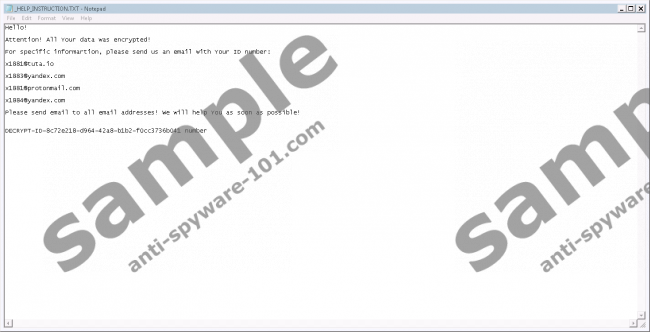What is X1881 Ransomware?
A new malicious application X1881 Ransomware, often referred to as crypto malware, has been detected. It has turned out that it is not exactly a completely new threat. Malware researchers have proof that it is a new version of CryptoMix Ransomware (you can read about it on your website). This new version is as dangerous as the previous one, so we are sure you will find a bunch of your files encrypted if it ever slithers onto your computer. Ransomware infections do not encrypt users’ files just to make fun of them. Malicious software developers use these infections to obtain money from ordinary users easier. Although X1881 Ransomware does not ask users to make a payment right away, we are sure you will be told when you write an email to cyber criminals that the only way to decrypt those locked files is to pay a certain amount of money to them. Needless to say, sending money to malware developers is the worst users can do because the chances are high that their files will stay locked. It does not mean that it is impossible to unlock the encrypted data without the special decryptor cyber criminals have – you could restore your files from a backup. The restoration of files should only take place when X1881 Ransomware is removed completely because it can launch automatically with the Windows OS due to the entry it creates in the Run registry key, meaning that you could not disable it and, as a consequence, it will strike again and lock those decrypted files.
What does X1881 Ransomware do?
X1881 Ransomware usually arrives on users’ computers illegally and then goes to encrypt their files right away. These files it encrypts get a new extension .x1881 appended to them. Additionally, their names are changed to a string of letters and numbers. For instance, the original file picture.jpg becomes 2ACA40714818120C7571D87F4CDCF654.x1881. When the encryption of files takes place, you should also be able to find a new .txt file on Desktop – _HELP_INSTRUCTION.TXT. Surprisingly, it does not contain any information about the ransom; however, we are still sure that you will be asked to transfer money in exchange for the special decryption tool. You should receive more information and payment instructions if you write an email with your unique ID to one of the email addresses provided (x1881@tuta.io, x1883@yandex.com, x1881@protonmail.com, or x1884@yandex.com). Do not even consider paying a ransom as one of the options because you have no guarantees that you could decrypt your files. To be frank, it is a common situation that users do not get anything from cyber criminals after transferring money to them, i.e., giving them what they want, so our only piece of advice for you is to delete X1881 Ransomware fully and then restore files from a backup, if it is possible.
Where does X1881 Ransomware come from?
Since X1881 Ransomware is not one of those prevalent infections, it is still not very easy to say how it arrives on users’ computers. According to specialists at anti-spyware-101.com, it should not differ from other ransomware infections much. That is, it should be mainly spread via spam emails. These emails contain malicious attachments or malicious links. In the latter case, the single click on this link is enough to allow the ransomware infection to enter the system. Without a doubt, it is only one of several methods used to distribute ransomware infections, so, in some cases, it might be very hard to protect the system without special security software. Therefore, our recommendation for you would be to acquire security software and install it on the system as soon as possible. Not all the tools claiming to be powerful security applications can recognize malware and prevent it from entering the system, so you should not install on your computer the first scanner you find available for download – it must be reputable and receive periodic updates.
How to remove X1881 Ransomware
X1881 Ransomware is not one of those sophisticated ransomware infections, but it creates its entry in the Run registry key, which allows it to continue working even after the system restart. Of course, you will need to remove this entry yourself, which will definitely not be a very easy procedure. Follow our manual removal guide if you have zero experience in malware removal. If you are sure you could not erase this infection yourself with our guide too, scan your system with an automated malware remover. We do not know any other easier way to delete serious malware.
X1881 Ransomware removal guide
- Press Win+R.
- Type regedit.exe and tap Enter to access the system registry.
- Go to HKCU\Software\Microsoft\Windows\CurrentVersion\Run.
- Locate the Value pointing to the malicious .exe file, right-click it, and select Delete.
- Remove the Value pointing to C:\ProgramData\{random symbols}.
- Close Registry Editor and press Win+E.
- Go to %USERPROFILE%\Desktop, %USERPROFILE%\Downloads, %TEMP%, and %ALLUSERSPROFILE%.
- Delete all suspicious recently downloaded files from these directories.
- Remove the ransom note _HELP_INSTRUCTION.TXT from Desktop.
- Empty Trash.
100% FREE spyware scan and
tested removal of X1881 Ransomware*

Stop these X1881 Ransomware Processes:





0 Comments.